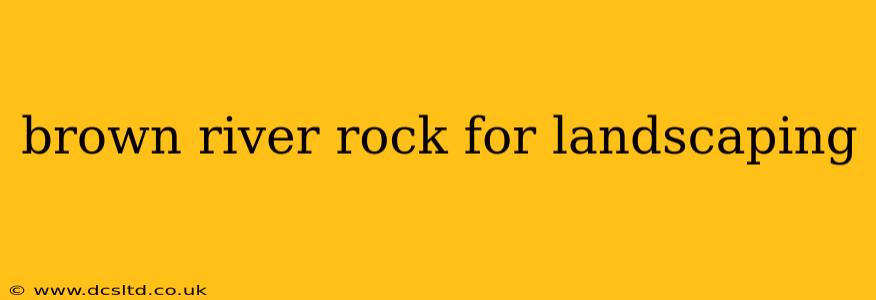Brown river rock offers a timeless and versatile option for landscaping projects, adding a touch of natural elegance to any outdoor space. Its earthy tones complement various plant life and architectural styles, making it a popular choice for homeowners and professional landscapers alike. This comprehensive guide explores everything you need to know about using brown river rock in your landscaping, from selecting the right size and type to ensuring its long-term beauty.
What are the Different Types of Brown River Rock?
The term "brown river rock" encompasses a range of sizes, shapes, and textures. While the unifying characteristic is their brown hue, variations exist due to the mineral composition and the riverbed from which they originate. Some are smooth and rounded from years of tumbling in the river, while others retain a more rough, jagged texture. Sizes typically range from pea gravel to large boulders, allowing for diverse applications in landscaping. When choosing, consider the specific needs of your project and the overall aesthetic you wish to achieve.
How Much Brown River Rock Do I Need?
Determining the quantity of brown river rock required for your project depends heavily on the area you intend to cover and the desired depth. Accurate measurement is crucial to avoid unnecessary expenses or shortages. Most suppliers offer calculators or can help you estimate based on your specifications. It's always wise to purchase a slightly larger quantity to account for unexpected needs or future expansion. Consider the size of the rocks; larger rocks will naturally require a smaller quantity to cover the same area compared to smaller rocks like pea gravel.
What are the Benefits of Using Brown River Rock in Landscaping?
Brown river rock boasts numerous advantages for landscaping:
- Low Maintenance: Unlike plants, river rock requires minimal upkeep. It's relatively resistant to weeds and pests and needs only occasional cleaning.
- Drainage: Excellent drainage properties make it ideal for areas prone to waterlogging, preventing soil erosion and promoting healthy plant growth.
- Versatility: Its adaptability allows its use in various landscape designs, from pathways and borders to dry creek beds and retaining walls.
- Durability: River rock is resistant to weathering and temperature changes, ensuring long-lasting beauty.
- Aesthetic Appeal: Its natural, earthy tones add a touch of rustic charm and sophistication to any outdoor space.
How Do I Install Brown River Rock in My Landscaping?
Installation is typically straightforward, but preparation is key. Begin by clearing the area of debris, weeds, and existing vegetation. Level the ground to create a smooth, even surface. You might need landscaping fabric to prevent weed growth, especially if you're using it as mulch. Then, simply spread the river rock to your desired depth and thickness.
What is the Best Way to Clean Brown River Rock?
Periodic cleaning will maintain the beauty of your river rock. A simple sweep or blow with a leaf blower is often sufficient to remove leaves and debris. For more thorough cleaning, you can use a garden hose to rinse away dirt and sediment. Avoid using harsh chemicals, as they could damage the rock's natural finish.
How Much Does Brown River Rock Cost?
The price of brown river rock varies based on several factors, including the size, quality, and source of the material, as well as the supplier's location and pricing policies. Larger quantities generally result in lower per-unit costs. Contacting local suppliers for personalized quotes is essential for accurate budgeting.
Where Can I Buy Brown River Rock?
Brown river rock is widely available from various sources, including landscaping supply yards, home improvement stores, and online retailers. Comparing prices and options from different suppliers ensures you secure the best quality at the most competitive price. Checking reviews is also essential for determining reliability and customer satisfaction.
What are Some Creative Landscaping Ideas Using Brown River Rock?
Brown river rock's versatility shines through in creative landscaping applications:
- Water Features: Create a visually appealing and functional dry creek bed or border for ponds and waterfalls.
- Pathways: Construct durable and attractive pathways that blend seamlessly with the surrounding landscape.
- Retaining Walls: Build robust retaining walls to stabilize slopes and prevent erosion.
- Mulch: Use as a decorative and practical mulch around plants and trees to suppress weeds and conserve moisture.
- Accent Pieces: Incorporate larger, uniquely shaped rocks as focal points or accent pieces in garden beds.
By understanding the various aspects of selecting, installing, and maintaining brown river rock, you can transform your outdoor space into a stunning and functional landscape. Remember to plan meticulously, choose the right supplier, and enjoy the enduring beauty of this natural element.
